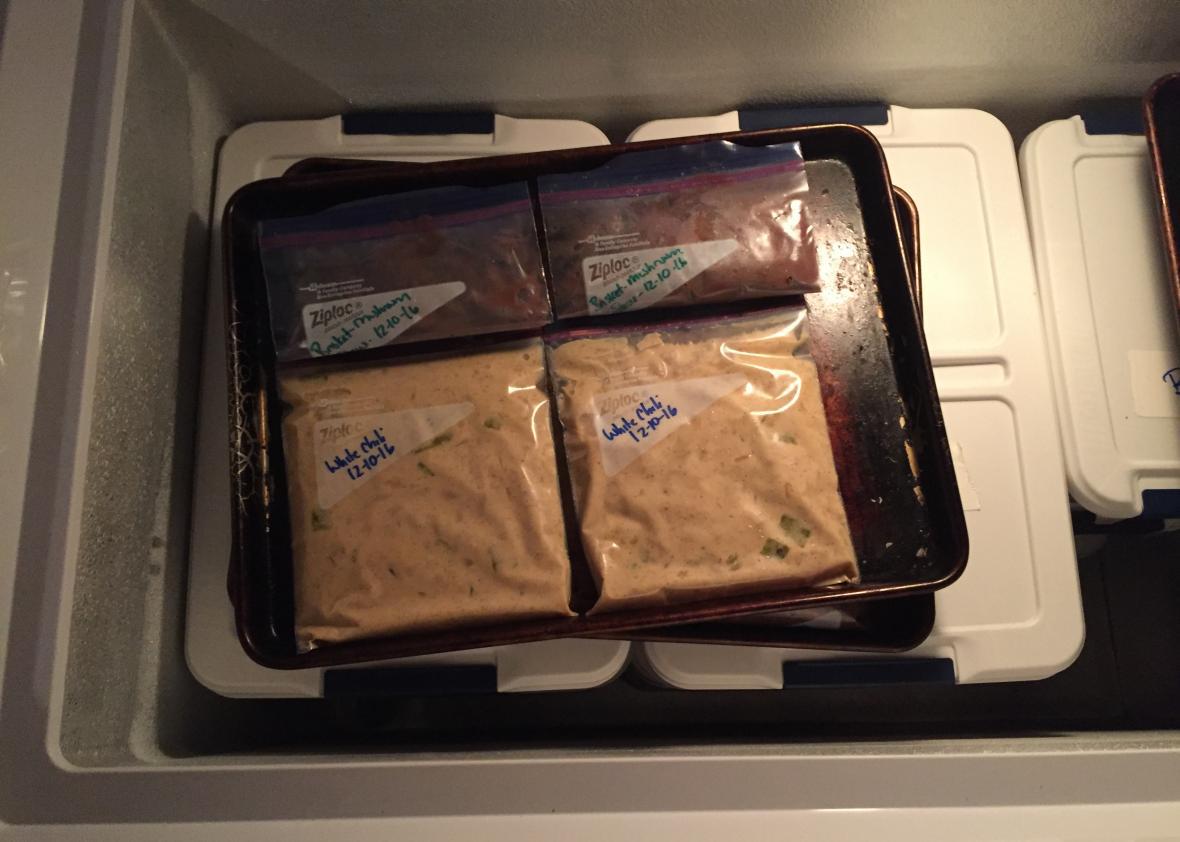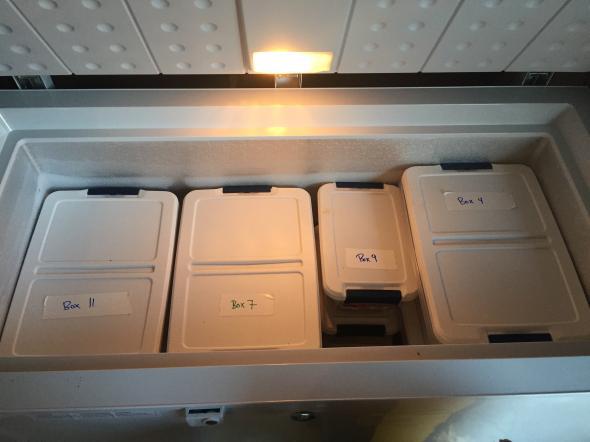Read previous food-storage tips from a refrigerator nerd.
When you’re expecting your first child, parents love to tell you how constrained your life will soon be. Any time you mention an activity you like—yoga classes, hiking, visiting museums—they’ll shake their heads and proclaim, “Say goodbye to all that!” It’s meant kindly, but it feels pretty terrible.
One of the activities I’m most afraid of losing is cooking and eating good food—and a wide variety thereof. So, before Thanksgiving, I ordered a medium-sized chest freezer for our garage. Since then, I’ve spent Sunday mornings in the kitchen, making three or four recipes for the freezer per session. (A calming bonus this particular winter: My Sunday-morning cookblitzes have been politics-free zones. I leave Trumpcast for other times.) I’ve also made double recipes—one for that night, one for the freezer—whenever a dinner is freezable.
A month later, the chest freezer is full: a time capsule, a gift from my pre-parenthood self to whatever changed being I might become in the future. It’s stocked with food from recipes I’ve made for years, cooked with ingredients that come from the farms and butchers around the town where we live. It feels like it could keep me … me. This is magical thinking, I recognize; the freezer’s bounty will only last a few months into my new child’s life, and then what? But filling it made me feel better.
Here’s how I did it.
Organization: I don’t understand how you could have a chest freezer without using some kind of bin system. Rooting around in an undifferentiated mass of frozen chickens and blocks of broth seems like an extremely unpleasant way to spend one’s time (not to mention, a good way to lose track of things).
I measured out the internal dimensions of my freezer and went to Lowe’s, where I got a group of Glad plastic storage bins with clicking handles. (My freezer fits eight big ones and three small ones.) I labeled each with a number. Because my bins have handles on either end, they’re easy to lift out of the depths of the freezer with one hand. I probably lose a little space this way, but the system pays me back in ease of use.

Rebecca Onion
Inventory: I’m keeping a running list of each numbered bin’s contents in my Evernote software. This is a little bit of a pain, but it means that I can be sitting on the couch indoors, looking at my phone, when trying to brainstorm a dinner or lunch, rather than standing in the garage, physically inspecting the contents of each bin. I bet that functionality will get even more important when I do have an infant. I think it’s worth the attentiveness. (You could do this with any list-making software that syncs between devices. My second suggestion would be Workflowy, but I’m sure there are many others that would work.)
Freezing techniques: I use quart-sized Ziploc freezer bags for anything that’s liquid: soups, stews, and broths. You can fill a number of these and lay them flat on a sheet pan to freeze. (Another advantage of my bins system: Those stacked bins create a nice spot at the top of the chest freezer to rest the sheet pans on.) I also just acquired a vacuum sealer (I bought a FoodSaver model) to use on individual portions of meat and baked goods. I am nowhere near as adept a vacuum-er as some people, but: baby steps.
And here’s what’s in my freezer so far.
Prepared foods
Soups and stews
These, of course, are everyone’s defaults for make-ahead freezing. I made soups and stews in a few different genres.
Chilis: I made a friend’s bean-heavy (and unpublished) vegetarian recipe, as well as an intensely savory white chicken-and-cannellini-bean version from a 2002 issue of Bon Appetit.
Bean soups: I made a Cuban black bean stew by the Splendid Table’s Lynne Rossetto Kasper. It’s a little bit more acidic than the mellower Whole Foods black bean soup, which I bought in their to-go aisle, splitting a few containers into two servings each for freezing.
Lentils: I love Food 52 user Antonia James’ lentil soup with spinach and sausage. I also made a few batches of Food 52 test kitchen chef Josh Cohen’s creamed lentils and kale, which is less of a soup and more of a delicious hearty mush. (I mean that in the best way.)
Tomato soups: I bought some tomato bisque from Whole Foods, and froze that, but I also made this slightly spicy, chunky red-beet-and-tomato version by Michael Stebner, which I saw in Food & Wine a few years ago.
Squash: I made butternut squash soup with cider cream, from an even older Bon Appetit, as well as a heartier variety that starts with a blended squash base and adds kale and sausage. I also buy and freeze Whole Foods’ sweeter triple squash soup.
Stews: I made three recipes’ worth of Julia Child’s boeuf bourguignon and froze it in precious portions. I associate this stew with my father, who puts it together for special occasions; the chest freezer contains no more sentimentally freighted substance.

Rebecca Onion
Other dinner foods
My husband isn’t as big of a soup fan as I am, so I’m experimenting with other ways of pre-prepping dinner via the freezer. I made a small batch of Bon Appetit’s winter greens gratin (I add bacon and sautéed mushrooms to the greens mix to make it more of a meal), baked it, and vacuum-sealed it right in its Pyrex dish. I doubled a lemony crab cakes recipe by Food 52 user The Original Dish, pan-fried them all, and froze half on a sheet pan, then vacuum-sealed them in groups of three. (These taste great slightly defrosted, then resuscitated in a cast-iron pan; no need to add more oil.) And I’m experimenting with freezing a friend’s (unpublished) recipe for feta-dill fritters in the same way: pan-frying a double batch, freezing, and vacuum-sealing. I haven’t tried to bring those back to life yet, but I have high hopes.
Baked goods
You can make any cookie recipe into a freezer recipe: just roll the dough into balls and pre-freeze on a sheet pan before vacuum-sealing (or Ziplocking) in groups. I did batches of brown sugar cookies (from Cooks Illustrated), browned-butter chocolate-chip (Lorie Baker, via Food & Wine), World Peace cookies (Dorie Greenspan), and tahini chocolate chip (Danielle Oron, via Food 52), vacuum-sealing each variety of dough in groups of six.
I made Smitten Kitchen’s chocolate stout Bundt cake, as well as two kinds of olive oil cake (Maialiano’s, via Food 52, and Saveur’s orange-scented version), and pre-froze them in quarters on a sheet pan, before vacuum-sealing each quarter separately. Same with a batch of Maia Heatter’s excellent peppermint-patty Palm Beach Brownies, which I froze and sealed in groups of four. I’ll defrost the cakes before eating, but not the brownies, which are even better when cold and chewy.
Finally, I’m experimenting with freezing Smitten Kitchen’s granola recipe, which is my standard breakfast food. I’ve vacuum-sealed half-recipes separately (without adding in the dried fruit).
Ingredients
Meats and proteins
I buy chicken thighs and breasts in bigger packages, and then vacuum-seal three or four (depending on their size), and freeze a group that way, so that I can defrost them dinner by dinner.
Likewise, I buy bacon in standard supermarket packages and then freeze groups of three or four slices in tinfoil. This makes sense for the way I cook: Usually, I need only a small amount of bacon to decorate the top of a soup or a dish of beans. So I just grab a tinfoiled bacon baton out of the freezer, chop it up into one-inch pieces while it’s still frozen, and fry it up in a cast-iron skillet; no need to defrost.
A few years ago, I had my mind blown by this piece about freezing tofu on Slate. In it, my colleague L.V. Anderson recommends draining the tofu before freezing, but I read somewhere else that you can also just pop the original container in the freezer, which is easier. I have a few tofu blocks on hand for future stir-frys.
Flours and meals
We have a great store in our town called the Bulk Food Depot. I inevitably leave there looking like a prospector loading up for the winter in a Yukon cabin, laden with sacks of cornmeal, raisins, and rice. Now that I have a chest freezer, I can follow the recommended path and freeze my backup whole-grain flours and meals, to avoid rancidness. (I just need to remember to defrost them before using, as Cooks Illustrated recommends, to avoid an overly dense baked good.)
Chocolate
I’ve long had difficulty keeping chocolate chips in stock, because certain people in my household will find them and eat them, no matter how deep I stow the bags in the baking drawer or the kitchen freezer. The chest freezer is my solution: I’ll buy Ghirardelli 60-percent chips whenever they’re on sale at the supermarket and stash the bags for future baking.
Butter
One of the freezer’s small bins is filled with a few pounds of unsalted butter, which I keep around out of a generalized fear of running out of the magic substance. I also stocked some of the Kerrygold spreadable tubs of Irish butter that aren’t sold in our Krogers here in town; I buy multiples every time I go to Whole Foods in Columbus, Ohio.
I also have a few blocks of pre-browned butter, wrapped in foil, in there, because I thought I’d make a batch of brown-butter chocolate-chip cookies one day and then realized I didn’t have chocolate chips. (See above.) I’ll experiment with defrosting it, and saving that step, later.
Broths
I make chicken broth whenever I have a carcass at hand. Now I finally have a spot to save it all. In the broth bin are also a few containers of the pork stock our local sausage vendor sells at the farmer’s market, which I like to use in that lentil-spinach-sausage soup.
That’s it, for now. I still have a few Sunday mornings left before my due date. Maybe I’ll try making and freezing batches of quesadillas or Smitten Kitchen’s fancy Emmentaler-on-rye grilled cheese sandwiches next. In a year, will the freezer be full of Trader Joe’s frozen dumplings? Perhaps. But don’t tell me—I’ll know soon enough.
